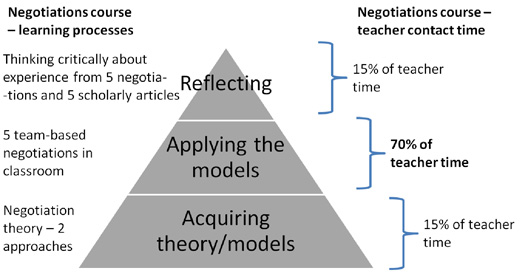
Department of Communication, Culture and Languages
BI Norwegian Business School
mark.brown@bi.no
Much of the impetus in introducing digital technologies has come from distance-learning courses rather than from traditional classroom-based activity. However, classroom-based teaching faces a resource squeeze for which digital technology offers a possible solution; in order to provide students with higher-level learning opportunities, teaching hours will probably have to be reallocated from lower levels of classroom-based learning activity. This article reports some results from a teaching project in which we moved a mid-level learning process out of the classroom and into a digital learning environment to free up teaching time for higher-level learning. The findings confirm previous work showing that students respond very positively to such reflective learning opportunities. More importantly, this article contributes to an understanding of how students, who are used to cooperating in a classroom, respond to being moved into a digital learning environment. The findings are based on results from a student questionnaire. The variation in responses to different aspects of the experience underlines the importance of offering choice in a digital learning environment.
Keywords: digital learning environment, higher-level learning, reflection, learning outcomes, community of enquiry, cooperative learning
This article makes a contribution to knowledge within teaching practice. It describes and reports some results from an attempt to use a digital learning platform to automate part of a learning process that has traditionally been classroom-based. The automation was intended to free up teacher contact time with students, so that more hours could be allocated to providing them with a higher-level learning opportunity (described later). This topic is relevant for teacher-practitioners who must grapple with the challenge posed by two opposing pressures. On the one hand, there is our professional ambition to provide students with higher-level learning opportunities. Unfortunately, these processes tend to consume a relatively large amount of teaching time, a fact that is at odds with the second pressure: a resourcing squeeze within education that wants to see fewer teaching hours per unit of learning.
One possible way of meeting this challenge is offered by digital technologies, whose promoters were quick to position them in this resource-squeeze discourse. One of their sales arguments claimed that administrative chores were simpler to carry out. Keller and Hrastinski’s (2009) survey of university teachers reported widespread acknowledgement that learning platforms are indeed useful in disseminating information to students and administering assignment submissions. (See also Lonn & Teasley, 2009; Weaver, Spratt, & Nair, 2008; Alexander & Golja, 2008). A more recent survey by Olsson (2011) corroborates their findings, reporting that the three most common usages of “ICT [Information and Communication Technology] are distribution of material, communication [and] administration” (p. 37). Generally then, digital learning platforms would now seem to be widespread throughout Scandinavia, but their usage is still concentrated on administrative functions and low-level learning processes.
If one narrows the focus from general usage to practitioners’ reports of specific applications of digital technology in specific learning processes, there is already a considerable bank of knowledge. Some articles in this journal report on the use of learning platforms in blended approaches to course design (Johansen, Harding, & Ljosaa, 2012; Hole, Larsen, & Hoem, 2010; Bjørke, 2011). (See also Akkoyunlu & Soylu, 2008; Condie & Livingston, 2007). The courses on which these studies are based have one important feature in common; because of the geographic separation of participants, none of them could have been offered as a purely face-to-face, classroom experience. An important difference between such work and this study is that the course which is the subject of this article is classroom based; bachelor-level students turn up at the same time weekly to participate in a negotiations course conducted by their regular teacher. We wanted to see how they would compare their normal classroom experience (i.e., negotiating a business case face-to-face with classmates) with the experience of negotiating remotely (i.e., within a digital environment with strangers).
Why change a learning process that already works well? Although improved versions of learning management software continue to be released, when compared with a real teacher, our experience is that they are still only useful for making evaluations of learning at the lower levels. With reference to the six-stage, modified-Bloom cognitive processes (Anderson et. al., 2001) they can clearly test Remembering and, arguably, Understanding. But prior to this trial we had no experience of using a digital platform to support a learning process at the Applying level. Indeed, the Applying learning activities that we had created for students were all face-to-face, classroom-based and very popular. One serious consequence of this popularity that we faced, a challenge which is probably typical for other teachers, is that in testing the usefulness of the technology in supporting higher-level learning activities, one risks moving students into digital environments that actually provide a poorer learning experience than the one they can get in their regular classroom.
However, current shortcomings in functionality should not be used as an excuse for inactivity. Those of us who teach within the relative luxury of a 36-hour, classroom-based course may expect the two opposing pressures to intensify; we will become more ambitious regarding our students’ learning outcomes, and limitations in public financing for higher education will mean less money per student. Simultaneously, digital learning platforms will become better. It is not a question of if. It is rather a question of when they will be good enough to move into higher-level learning processes and how we can use them successfully to improve overall learning outcomes. We must build our understanding of how in preparation for when.
The technology must, of course, be the servant of the learning processes (Vogel & Klassen, 2001). In the next major section, therefore, I conceptualise the course we teach within a simplified-Bloom hierarchy of cognitive learning, to pedagogically position the role of the technology. For current purposes, it is sufficient to mention that I conceive most of the learning processes in our course to be heavily constructivist rather than, following Bjørke (2011), “instructivist.” Within our own teaching group, however, the debate prompted by the advance of e-learning technologies is revealing that there is this difference in conceptualisation among us. Different members of our group conform fairly well with the three-level description provided by Biggs (2003, pp. 20-25). For those teachers who conceive of learning as a largely objective mass of facts and ideas, the teaching process is about broadcasting material, while the students’ learning process is about receiving, storing and reproducing it. The first generations of digital learning platforms did not threaten such a viewpoint. They simply offered an electronic channel for transmitting the knowledge as a supplement to the teacher (see, for example, Garrison & Anderson, 2003, pp. 34-39 and Billing, 2007). As already mentioned, the multiple-choice quizzes that we have placed on the learning platform are able to test Remembering and arguably, Understanding, but no more.
The newer versions of platforms now claim functionality such as sharing, collaborative writing and cooperation (its learning, 2013; fronter 2013). Underpinning this technology is a more constructivist assumption of what learning is; students work, often in groups, at applying ideas to construct new understandings. For the constructivists in the staffroom, these recent advances in technology are an exciting development, but for the instructivists they are an irrelevance. So the technology has initiated an important and long overdue internal discussion about exactly what we understand by the term good learning. That said, I am not a one-size-fits-all social-constructivist. One valuable contribution from Olsson (2011) is in reminding us that different subjects have different learning processes. He reports, for example, that lecturers in chemistry and biology – two of the natural sciences – showed highest agreement with the claim that “learning is an individual process” (p. 38). A moment’s reflection on the knowledge base in these two subjects suffices to show why they hold this opinion.
Continuing the theme of good learning, Oltedal reports student experience of a digitally supported reflective learning process. She describes her “competence meetings” as an “arena for reflection … on theory and practice” (2009, p. 2) and the task assigned to the students conforms closely to the one described in this article. Her findings are also broadly positive and they provided some guidance in our project design at the BI Norwegian Business School. First, her on-campus students liked the reflective learning process. However, there is no indication that they were comparing their digital experience with an experience they had had in a previously organised reflective process in a classroom. The comment from one of the on-campus students is that she “underscores the new experiences and learning that result [from the competence meeting]” (p. 10), which suggests that the process itself was new. Oltedal’s findings give good grounds to believe that reflective learning processes are appreciated by students, (see also Harrison, Short & Roberts, 2003). However, they are not necessarily an endorsement for applying technology for on-campus students who can meet each other face-to-face relatively easily. The second finding relevant for this project was the feedback from several students that a high level of participation was important for the process. Therefore, to motivate students to participate, the project allowed student groups that submitted their jointly written reflective assignment by the deadline to book a half-hour tutorial with their teacher to discuss their reflections.
One seemingly, unavoidable consequence of providing students with such a high-level learning experience as the one described by Oltedal is the heavy investment in teacher resources that is needed, not to teach, but to advise or evaluate. If teachers are to engage with their students’ thought processes, our experience shows that that they must spend considerable time with their material, whether it be a video of a meeting or a written assignment. Recognising the resource squeeze referred to earlier, one assumption of our project was that this requirement would have to be met by resource savings made lower down the learning hierarchy. The first general research question, therefore, was formulated as follows:
Assuming that teaching resources which are freed up by an automation process at a lower level of learning, are allocated to a new higher-level learning process, will the students experience an increase in their learning outcomes as a consequence of the new process?
This leads to exploring the automation possibilities in lower-level learning activities which digital technology is beginning to offer. But it is important during this process not to lose sight of the ultimate pedagogical goal: better overall learning. The general research question for this area of understanding can be formulated as follows:
When a learning process at a lower level is automated, will the students work with less, the same, or greater diligence and will their learning outcome be less, the same, or greater than it was before the process was automated?
All teachers will have to rework these research questions within the context of their courses; their understanding of how learning takes place, the processes they have designed to support student learning, and the automation and augmentation of processes that they propose to make. But crudely stated, if the answers to the research questions point to an aggregate increase in learning outcomes, then the pedagogic case for change has been made.
It is in this area of digital automation that this project makes a contribution. As mentioned earlier, the digital platforms are now able to help with checking for student acquisition of facts and terminology and also, arguably, with checking for students’ understanding of the more basic theoretical concepts that we want them to learn. But there are limits to what one can do with multiple-choice questions. In the next level up the modified-Bloom cognitive hierarchy – Applying – students attempt to use the theory or model they have acquired in some task. We are fortunate that in our course on negotiating, students play roles in business cases. This is an Applying learning activity that lends itself to a digital arena. In many other courses, the Applying process must be a practical task that may not lend itself to automation by a learning platform. Although the software we used could not fully automate the management of the process, we created a digital environment in which students prepared for a business negotiation, negotiated, and then reflected on their experience. Afterwards, they responded to an electronic questionnaire in which they were asked to make an explicit comparison between a classroom-based negotiation three to four weeks earlier and the digitally based negotiation just completed. The findings suggest that moving student activities out of their classroom setting and into a digital arena can be experienced positively. In the next section, I have conceptualised the course within a Bloom-inspired model of cognitive learning. This enables me to refine the two general research questions and to position pedagogically technology’s role in students’ learning activities.
The course which is the subject of this study offers learning of two negotiation theories and then practice in their application in five different cases. Due to limitations in teaching resources, there is little teacher-managed work for students in reflecting on how well the negotiation theories worked in practice. Students are left largely on their own at this high level of learning. Their learning process is summarised in the three layers of the pyramid in figure one, which is a simplification of the six-stage, modified-Bloom cognitive process dimensions (Anderson et al., 2001, p. 28). Our experience as practitioners is that these three layers provide a sufficiently well delineated conceptual framework with which to work. Making more fine-grained subdivisions, such as in Bloom’s taxonomy, leads, at this stage of our journey at least, more to confusion between teachers about what is what, rather than providing any productive pedagogical insight.

Figure 1: Three-layer model of cognitive process (simplified from modified-Bloom) with negotiations course learning process (on left) and current allocation of teacher contact hours (on right).
The syllabus includes the two major models for approaching a negotiation situation: (i) integrative and (ii) distributive, negotiation theory. They are provided in one book: Getting to Yes, (Fisher, Ury, & Patton, 1997) and by a 30-page chapter from Essentials of Negotiation (Lewicki, Barry, & Saunders, 2007). At this first level of their learning, students acquire the theoretical knowledge in cognitive processes which we equate with the Remembering and Understanding of the modified-Bloom model. Following Anderson et. al.’s knowledge dimension (p. 28), we are inclined to consider the syllabus material to fall within their categories of Factual and Conceptual knowledge. The digital learning platform has been furnished with some simple multiple-choice questions which give students an idea of how well they remember this material. Some of the questions offer students alternative definitions of particular terms and ask them to select the right one. (Opinion within the teaching group varies as to whether such questions prove that a student who picks the right answer has actually mastered the concept). Currently, utilisation of the digital learning platform is limited to course administration and to support for these two processes and this is what we understand by the term lower-level learning. Perhaps reflecting the reservations of some of the teachers referred to above, we also spend some classroom time helping with and testing students’ understanding of the two theories – an estimated 15% of teaching time.
A course booklet contains five business cases that the students negotiate (Brown & Cleaverley, 2010). This learning activity is level two in our simplified model and has a one-to-one correlation with the simplified Bloom level of Applying; students try to apply the two theories in these five practical situations. The learning activity is heavily constructivist. Student teams start by building up an agreed interpretation of the business situation in which they have been placed. They go on to discuss alternative approaches which are offered by the two theories to decide on the combination that – in their opinion – will give them the greatest chance of achieving their objectives in the negotiation.
Although students prepare outside the classroom for the negotiations, it is at this level of learning that teachers invest most of their student contact time; an estimated 70%. There is a final preparations stage in the classroom in which teams can hone their strategy and teachers can check that they are prepared. This is followed by the negotiation phase, during which teachers observe and, occasionally, offer advice during time outs. Finally, there is a post-negotiation documentation phase, in which students make notes on the deal agreed and any additional thoughts on the process of trying to apply negotiation theory in practice. Throughout, the focus is on student activity, so the teachers mostly play an administrative rather than teaching role.
Students like the negotiations. The goal of negotiating the best deal is invaluable in motivating them, particularly the non-academic “Roberts” (Biggs, 2003). However, for many students the task becomes an end in itself rather than a step on the learning pyramid. Cognitively, once the deal has been negotiated, we want the task-oriented negotiating teams to morph into the sort of communities of inquiry envisaged by Garrison and Anderson (2003). It is time for them to reflect on their attempt to apply negotiation theory in practice. Instead, the students want to compare the deal they negotiated with the ones negotiated by other teams. A second advantage in this mid-level learning process also becomes a problem when we try to move students up to the higher-level reflective learning activities. Although the process, properly executed, requires note taking, students experience it as an oral activity and thus write very little, which means there is no detailed record of exactly what happened. Students are expected to reflect on verbally mediated processes which only exist in their own memories and, perhaps, in a few hastily written notes.
In its current teaching form, the course does not provide students with sufficient opportunities for reflecting, a term which we use interchangeably with higher-level learning. The 15% of time allocated to reflecting allows for no more than a teacher-focused summary of observations using the white board. The situation is much as Biggs (2003) portrayed it; the academic “Susans” spend time after each negotiation discussing their experiences. They record specific instances in which the application of a theoretical idea had its expected outcome, and those in which the theory was not so successful in dealing with the negotiation practice. These latter examples are an opportunity for analysis; why did the theory work well in situation x but fall short in situation y? This form of cognitive learning is what we understand by the modified-Bloom terms of Analysing and Evaluating. Conceivably, an outstanding academic Susan might even reach such a high level of insight into negotiation theory and practice that she would make new proposals for modifying theory. This level of cognitive learning is what we understand by the modified-Bloom top level of Creating, but this is a bachelor-level course and therefore such an ambition level is, mostly, unrealistic. Our learning expectations and activities are not fine-grained enough to make a distinction between Analysing, Evaluating, and Creating. As teacher practitioners, we roll them into one: reflecting.
While inadequately provided for in our teaching process, the grading guidelines for the oral exam are explicit in stating the course’s higher-level learning ambitions. Students are initially asked questions at lower levels of learning outcome. However, in order to get an A grade, they must display clear evidence of reflecting on the process of applying theory:
The internal examiner will be most interested in your reflections about how you were able (or not able) to apply the negotiation theory in the practice of this case ... The internal examiner will also be interested in your thoughts on the relevance or usefulness of the different negotiation theory articles. The examiners would like to emphasize that these articles should make an important contribution to your own reflections over negotiation theory [emphasis added] (Brown, 2010).
The deliberate reference to higher-level learning outcomes in the grading guidelines makes explicit a misalignment, to modify the meaning of Biggs’s (2003) term, between classroom learning activities and the evaluation of student learning outcomes in the exam (see figure two). The relatively small amount of time that teachers have available for this stage of the learning process unfortunately sends the wrong signal to students about its importance.
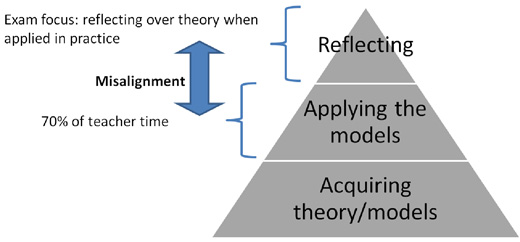
Students have always rated negotiating the deal as the best part of the course and there is an understandable reluctance to make changes to a winning team, particularly so with respect to our non-academic Roberts. But to align teacher resources with the course’s higher-level learning ambitions, we must take the students out of their teacher-managed, face-to-face, classroom negotiations and place them and their multi-stage negotiation process in a digital environment. The first research question was formulated as follows:
(1) When the teacher’s presence is withdrawn from the negotiation process, will the students work with less, the same, or greater diligence in trying to apply theory to practice, and will their learning outcomes be less, the same, or greater?
We did identify one clear advantage of the automation process; the digital capture of the negotiation would provide students with the raw material on which we could base a reflective assignment. It was to be written by each negotiating team following their online negotiation and would then be reviewed by a teacher and the team during a half-hour tutorial. This process formed the experimental foundation for the second research question which was formulated as follows:
(2) When the negotiation process is augmented with a written assignment and subsequent teacher feedback, will the students experience an increase in their learning outcomes?
The next section describes setting up a project that attempted to answer the two research questions.
This work is an act of faith; eventually the technical functionality of these learning platforms will deliver what we need. But a healthy scepticism to the optimistic claims of the IT promoters is also fine and in this case the sceptics were proved right; the learning platform functionality could not completely replace the teacher in administering the negotiation process. The limited saving of teacher input time at this level meant there would be very little time to reallocate to the reflecting level. The choice was straightforward; either (a) stop the project and wait until the learning platform technology could deliver exactly what we wanted, or (b) view the project as an opportunity to explore the pedagogic questions and find some money to support it. We are not adherents of a big-bang approach to change. Incremental improvements are more easily managed by both teachers and students. Just as important as the system developments is the need for we teachers to develop our digital literacy (Buckingham, 2006; Keller & Hrastinski, 2009). Fortunately, we received funding to pay four teachers for their extra time, so the project proceeded according to plan.
Four classes and their respective teachers were involved, one class each from the BI schools in Bergen, Stavanger, Drammen, and Oslo. A total of 106 students were organized into 26 negotiating teams. Seven teams in Bergen negotiated with seven in Drammen, and six in Stavanger negotiated with six in Oslo. The project was divided into five stages as shown below and ran from late January 2011 to early March, an elapsed time of four to five weeks according to how quickly each team completed the process. The students negotiated case one using the traditional classroom approach before embarking on the project, during which they would negotiate case two:
(1) Stage one: preparing for the negotiation
(2) Stage two: negotiating with a student team in another BI location
(3) Stage three: writing the post-negotiation reflective assignment
(4) Stage four: participating in a tutorial with the class teacher
(5) Stage five: voluntary completion of questionnaire about learning experience.
Stages one and two supported learning at the second, applying-the-model level. The most important change in the learning environment was that the negotiating arena of stage two used EtherPad (2012) and required teams to communicate in writing. EtherPad is a web-based, real-time, collaborative document editor; its written log of the negotiation was essential for the reflective assignment in stages three and four.
The aim of stages three and four was to raise student learning outcomes at the higher reflective level of learning. Following their negotiation, the teams were given a 500-word assignment, the start of which is shown here:
In Getting to Yes the authors suggest that by inventing options for mutual gain, negotiators may be able to create win-win opportunities for the two sides … This process and its results, they argue, will increase the chances of the two sides reaching a mutually beneficial negotiated agreement.
(i) Discuss whether you were able to follow this advice in your negotiation of case two. Make reference to exchanges from your negotiation log to give examples of such attempts.
(ii) Reflect over the extent to which such a process helped to resolve negotiating difficulties between the two sides and give examples from your log to illustrate your thinking …
Maximum length of assignment: 500 words. Deadline for submitting assignment to your teacher is Thursday 24 February at 16:00 (Brown, 2011, p. 61).
As their reward for completing the assignment, the students then received a 30-minute tutorial with their class teacher in which they received feedback on the assignment and discussed their ideas.
The most appropriate technique for measuring student learning outcomes would be to use an exam, but setting up a trial exam was deemed to be too costly to organize and administer. For this reason the measurement technique adopted was an electronic student questionnaire – stage five – in which students were asked to assess their perceived learning outcome from the project.
The project’s first four stages were carried out according to plan in the spring semester of 2011. The biggest problem involved the voluntary completion of the student questionnaire, which only 51 of 106 students completed. It had 32 questions, mostly of a multiple-choice type and was divided into four main sections, which corresponded to the project’s four phases. There was also a short final section in which students expressed their overall satisfaction with the entire process. The questions invited students to compare their learning experience in the traditional, face-to-face negotiation process of case one, which they had completed in late January, with the new negotiation process of case two. Most questions offered five alternatives which ranged from “much worse” and “worse” through “no difference” to “better” and “much better.”
I begin with the response to research question two – experience from the reflective learning process – because the findings are just what we hoped for and not unexpected. In figure three, students’ feedback is presented graphically. The “- / +” column in the centre of the bar charts indicates the percentage of students who did not experience any appreciable difference between the traditional negotiation process of case one and the new form in case two. The “- -” and “++” of the charts correspond to the extreme opinions of “much poorer” and “much better.”
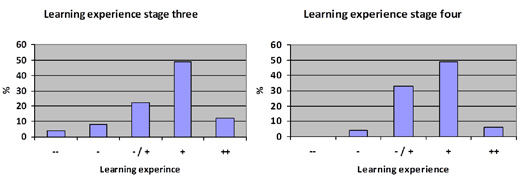
Figure 3: Comparison of perceived learning experiences from the reflective processes in stages three and four (vs case one).
The learning experiences referred to in stages three and four were the reflective assignment and the teacher-led tutorial. The comparison students made is between these two activities and the experience of being left on their own after negotiating case one. For those students who participated in stages three and four, roughly 80% thought they had learnt more. The results indicate that it is possible to raise activities and learning goals to the reflective level and that among students who rise to the challenge, an overwhelming majority think they learn more. But it is also important to note that a very small number of students thought the process had negatively affected their learning.
However, excellent results at a reflective level do not guarantee an improvement in the overall learning experience. In the final question of their questionnaire, students were asked to complete the following statement: “In an overall comparison of the classroom-based negotiation of case one with all four stages in the net-based negotiation project, I would say that my learning experience was …” The results are presented graphically in figure four. On the one hand, it is gratifying to note that 53% of students had a better or much better learning experience in the net-based negotiation of case two than they did in the traditional classroom negotiation of case one. However, 20% of students had a worse or much worse experience – a fact to be borne in mind which is discussed later.
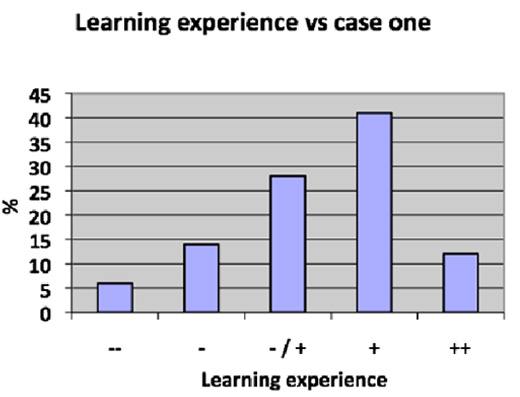
Figure 4: Overall comparison of perceived learning experience from project vs case one.
The answers to four questions are presented in figure five and reveal that, among the 51 students, participation in the project declined as the process progressed. The chart shows that 90% participated in the planning process of stage one whereas participation declined to 65% for the tutorial with the teacher (stage four) – a finding discussed in the next section.
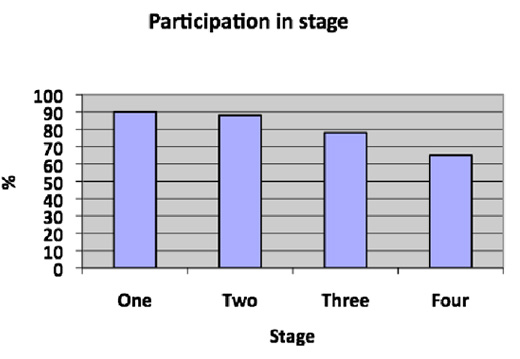
Figure 5: Level of student participation in the four stages of the project.
This question was formulated as follows: “When the teacher’s presence is withdrawn from the negotiation process, will the students work with less, the same, or greater diligence in trying to apply theory to practice and will their learning outcomes be less, the same, or greater?” First, I should repeat that our customisation of the learning platform software was not sophisticated enough to remove teachers from the process, which is most accurately understood as an electronic environment in which teachers intervened at specific points to check that things were proceeding to plan. Anecdotal evidence from teachers was that students appeared to be just as enthusiastic about the negotiation process as they had been a few weeks earlier in the first case. However, such evidence is no substitute for a truly teacherless digital environment and student responses, so we look forward to trying the process again with a more sophisticated version of the software. We did, however, learn some valuable lessons from student feedback on the three key changes that we had made to their negotiating experience.
The first change was that student teams negotiated with a team of strangers – students from another BI location – rather than with another team from their own class. Although about 15% of students felt less motivated (see figure six), this change was a positive contribution for motivating a clear majority of students (however, see discussion in next section).
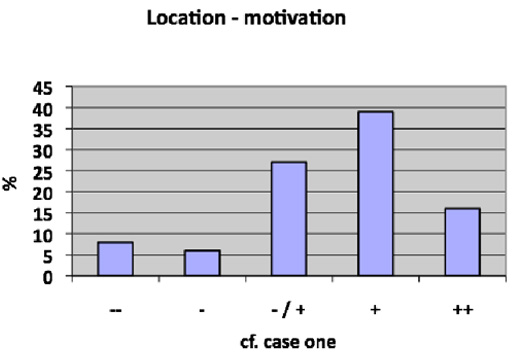
Figure 6: Students’ self-perceived motivation due to geographic separation in the net-based negotiation of case two compared with the classroom negotiation of case one.
The second change was that instead of seeing the other team face-to-face and being able to read body language, student teams negotiated on a PC screen without visual feedback. We had expected that students would experience this lack of visual feedback as a significant weakness of our system. However, as figure seven shows, most students felt more motivated to work on the negotiation as a result of this change in the communication form.
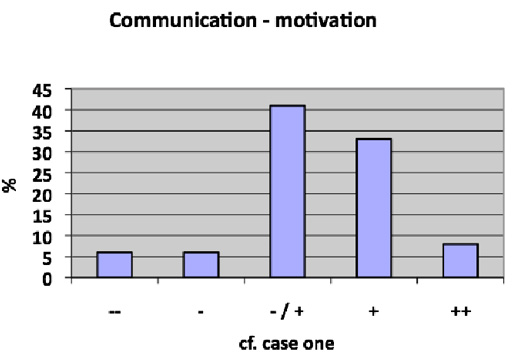
Figure 7: Students’ self-perceived motivation due to communication differences in the net-based negotiation of case two compared with the classroom negotiation of case one.
The third change that was forced on students by the digital arena was that they had to negotiate in writing rather than orally. Our classroom experience is that oral activities are always more popular with students than written ones, so we were prepared for negative feedback. However, the chart in figure eight shows a much more balanced picture. Certainly, some students were less motivated, but a slightly higher number were more motivated and the largest number reported that having to write rather than speak made no appreciable difference to their motivation.
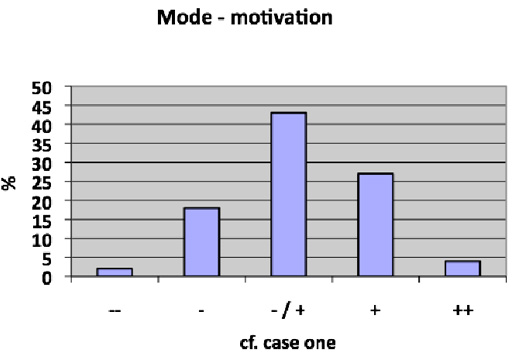
Figure 8: Students’ self-perceived motivation due to having to write in the net-based negotiation of case two compared with speaking in the classroom negotiation of case one.
The findings for research question two confirm those of Oltedal (2009). It is possible to create higher-level learning activities for students and some respond by working on them and, by their own assessment, learning more. However, these findings should be tempered by what the questionnaire response rate implies – 51 out of 106 possible – and by students’ reported levels of participation. It is reasonable to assume that these 51 respondents were the more motivated out of the 106. If we then assume that their participation levels are not representative for the group of 106, then perhaps as few as 62% of 51 = 35 students followed the learning process all the way up to the tutorial. The very positive findings may be feedback from just 35 academic Susans in a group with a total of 106 students.
Research question one: withdrawal of teacher presence from negotiation and overall learning outcomes
55 students did not fill in the questionnaire and therefore we know nothing of their experience. In addition, the findings from figure four show that about 20% of students who did complete the questionnaire, experienced a poorer learning experience when compared with the first negotiation case. For them, the digital arena was a clear step backwards from their face-to-face, classroom experience of case one. We need to find out more about their experience. It is not legitimate to make changes that will benefit one group of students when we have clear evidence that the same changes will be disadvantageous to another group.
One clear lesson we can draw from the project is that the learning platform software is not yet sophisticated enough to automate the applying-the-models learning activities. Despite the project’s failure on this point, our basic assumption about the technology is still in place; future releases of such software will enable teachers to reduce their input time at this level of learning. It is a question of when and not if. Another important lesson for teachers working in classroom-based, as opposed to distance, learning is not to be afraid of testing new digital techniques that replace the immediate personal contact that we appreciate so much. The students are much more open to using technology as a replacement for face-to-face contact then we expected. They did not experience the oral-to-written change as negatively as we expected because they are much more used to the orally written communication style of Facebook and texting.
The positive feedback on negotiating with strangers in another BI location may not be something that can be extrapolated to other learning environments. Most learning experiences of applying theory are probably characterised by a spirit of cooperation. Although our negotiation role-plays also provide opportunities for teams to gain by cooperating with each other, there are also aspects in which a competitive approach to the other side is advantageous. Many of our students latch onto this latter aspect which certainly functions as a good motivational factor; so, the positive response to negotiating with students in another BI location may simply reflect an extra kick from the chance to beat a team of strangers.
An important critical reflection to note is not to allow the theoretical model to dictate the conclusions drawn. Although Biggs’ Robert-Susan idea is helpful in reminding us that students come to our learning processes with differing cognitive ‘kitbags’ and motivations, we must not fall into the trap of thinking that we have just two types of student in the classroom. Between the archetypes are many different students and this becomes clear in studying the findings for research question two; we have not and will not get clear answers from our classes. Our students learn in different ways, and it is reasonably clear that digital learning environments that cater for this variety are more likely to succeed. For example, there is no reason why the digital capture of the negotiation must be in written form. It had to be written in this project because EtherPad was the only solution we could find that could reproduce a log of the process. But if Skype eventually offers functionality to record and present both ends of its video conversation, this technology could be integrated into the learning environment alongside EtherPad and student teams could be offered a choice of negotiating arenas.
The potential to offer students choice in selecting their learning processes is a key attraction and a competitive advantage that digital technologies have over our limited attempts to cater for different needs in the classroom. The theory of cooperative freedom (Paulsen, 2008) is a useful tool here for reflecting over the development of our system. For example, the EtherPad-or-Skype selection just mentioned would be classed as a medium facet of flexibility in his model. To offer student teams such a choice would be an attractive feature of the next version of the software.
It is always necessary, as Paulsen points out, “to find a reasonable balance between individual flexibility and participation in the learning community” (2009, p. 7), but what is our learning community? Although we have several hundred students taking part in this course across the different BI locations, we have been used to thinking of them as 15 separate learning communities each of 30 students and one teacher. As the digital arena develops in sophistication, one can imagine that individual students will be able to establish their own negotiating teams in accordance with their personal “cooperative learner profiles” (Paulsen, 2008, p. 13). When this happens the learning community will change as well and we may lose our role as teachers of a particular class of 30 students. Such cultural shifts take time – another good reason for making incremental change. We look forward to developing and testing version two of the digital negotiation arena.
Akkoyunlu, B. & Soylu, M. Y. (2008). A study of student's perceptions in a blended learning environment based on different learning styles. Educational Technology & Society, (Vol. 11–1), 183–193.
Alexander, S. & Golja, T. (2008). Using students' experiences to derive quality in an e-learning system: An institution's perspective. Educational Technology & Society, (Vol. 10–2, 17–33.
Anderson, L. W., Krathwohl, D. R., Airasian, P. W., Cruikshank, K. A., Mayer, R. E., Pintrich, P. R., Raths, J., & Wittrock, M. C. (eds.), (2001). A Taxonomy for Learning, Teaching, and Assessing: A Revision of Bloom’s Taxonomy of Educational Objectives. New York: Longman.
Biggs, J. (2003). Teaching for Quality Learning at University. 2nd ed. Maidenhead: Open University Press.
Billing, D. (2007). Teaching for transfer of core/key skills in higher education: Cognitive skills. Higher Education, (Vol. 53–4), 483–516.
Bjørke, S. Å. (2011). E-learning for sustainable development – rationale, strategies, choices and actions. Experiences from the study programme MSc in Development Management. Seminar.net: Media, Technology & Lifelong Learning, (Vol. 7–2), 79–93.
Brown, M. (2010). SPÅ 2902: Examination procedure and grading guidelines – information for students. Oslo: BI English group. Unpublished.
Brown, M. (2011). Climbing the learning pyramid using a learning platform, Oslo: BI report to management. Unpublished.
Brown, M. & Cleaverley, P. (2010). Business Cases for Negotiation: Student Handbook, Oslo: BI. ISBN 978 82 7042 9578.
Buckingham, D. (2006). Defining digital literacy – What do young people need to know about digital media? Nordic Journal of Digital Literacy, (04), 263–276.
Condie, R. & Livingston, K. (2007). Blending online learning with traditional approaches: changing practices. British Journal of Educational Technology, (Vol.38–2), 337–348.
EtherPad (2012). EtherPad Open Source Release. Retrieved from http://code.google.com/p/etherpad/wiki/Instructions.
Fisher, R., Ury, W., & Patton, B. (1997). Getting to Yes: Negotiating an agreement without giving in. London: Arrow Books.
Fronter (2013). Retrieved from http://no.fronter.info/produkt/.
Garrison, D. R., & Anderson, T. (2003). E-Learning in the 21st Century: A Framework for Research and Practice. London: RoutledgeFalmer.
Harrison, M., Short, C. & Roberts, C. (2003). Reflecting on reflective learning: the case of geography, earth and environmental sciences. Journal of Geography in Higher Education, (Vol. 27–2), 133–152.
Hole, G. O., Larsen, A. K., & Hoem, J. (2010). Promoting the Good e-Teacher: Didiactical Choices when developing e-pedagogical Competences. Seminar.net: Media, Technology & Lifelong Learning, (Vol. 6–3), 296–313.
Itslearning (2013). Retrieved from http://www.itslearning.eu/features.
Johansen, E., Harding, T., & Ljosaa, T. M. (2012). Seminar.net: Media, Technology & Lifelong Learning, (Vol. 8–1), 54–70.
Keller, C., & Hrastinski, S. (2009). Towards Digitally Literate University Teachers. Nordic Journal of Digital Literacy, (02), 104–113.
Lewicki, R. J., Barry, B., & Saunders, D. M. (2007). Essentials of Negotiation. Boston, MA: McGraw Hill.
Lonn, S. & Teasley, S.D. (2009). Saving time or innovating practice: Investigating perceptions and uses of Learning Management Systems. Computers & Education (Vol. 53–3), 686–694.
Olsson, U. (2011). Lecturers’ Conception of Learning and Use of Methods in Blended Learning Courses at Three Swedish Universities. Seminar.net: Media, Technology & Lifelong Learning, (Vol. 7–1), 34–45.
Oltedal, S. (2009). Using Competence Meetings as a Practical Reflective Method. Seminar.net: Media, Technology & Lifelong Learning, (Vol. 5–2), 1–16.
Paulsen, M. F. (2008). Cooperative Online Education. Seminar.net: Media, Technology & Lifelong Learning, (Vol. 4–2), 1–20.
Vogel, D. & Klassen, J. (2001). Technology-supported learning: status, issues and trends. Journal of Computer Assisted Learning, (Vol.17–1), 104–114.
Weaver, D., Spratt, C. & Nair, C. S. (2008). Academic and student use of a learning management system: Implications for quality. Australian Journal of Educational Technology, (Vol. 24–1), 30–41.
__________________________
Mark Brown is an associate professor at the BI Norwegian Business School in Oslo, Norway where he teaches bachelor-level communication courses. His research interests are in (i) sustainability communication and (ii) developing the learning environments of his students in ways that are pedagogically sound. This article describes such a process.